ASRock Rack C2750D4I Review: A Storage Motherboard with Management
by Ian Cutress on April 29, 2014 9:00 AM EST- Posted in
- Motherboards
- Storage
- Atom
- ASRock
- Silvermont
- Enterprise
- server
- Avoton
ASRock C2750D4I In The Box
Server motherboard packages are almost confusing. On the one hand it is a premium product that should get premium treatment, especially if it is end-user facing rather than server customer facing. The counter argument to this comes from server motherboard users knowing exactly what they want to use, so why waste money adding equipment that might not be applicable? The variation of cases or server chassis mean it is almost pointless to add something like a USB bay or rear bracket.
Nevertheless ASRock offers the following with the C2750D4I:
Driver DVD
Manual
Rear IO Shield
Four SATA Cables
Being a motherboard aimed at storage we should be glad that at least some cables are there, but this is only 1/3 of the number of SATA ports on the motherboard. In a server case I would imagine that all the cables are of appropriate length, and that can be hard to judge – so some is better than none but not as useless as more. If that makes any sense.
Many thanks to...
We must thank the following companies for kindly providing hardware for our test bed:
Thank you to OCZ for providing us with 1250W Gold Power Supplies and SSDs.
Thank you to ADATA for providing us with memory.
Thank you to ASUS for providing us with the AMD HD7970 GPUs and some IO Testing kit.
Thank you to MSI for providing us with the NVIDIA GTX 770 Lightning GPUs.
Also thank you to Silverstone for sending us the DS380 case.
Test Setup
| Test Setup | |
| Processor |
Intel Avoton C2750 8 Cores, 2.4 GHz (2.6 GHz Turbo) |
| Motherboards | ASRock C2750D4I |
| Cooling | Basic 8cm Fan |
| Power Supply |
OCZ 1250W Gold ZX Series Silverstone 300W SFX PSU |
| Memory | ADATA XPG V1.0 2x8GB DDR3L-1600 9-11-9 1.35V Kit |
| Memory Settings | XMP |
| Video Cards |
MSI GTX 770 Lightning 2GB (1150/1202 Boost) ASUS HD7970 3GB (Reference) |
| Video Drivers |
AMD Catalyst 13.12 WHQL NVIDIA Drivers 332.21 WHQL |
| Hard Drive | OCZ Vertex 3 256GB |
| Optical Drive | LG GH22NS50 |
| Case | Silverstone DS380 |
| Operating System | Windows 7 64-bit SP1 |
| USB 2/3 Testing | OCZ Vertex 3 240GB with SATA->USB Adaptor |
Power Consumption
Power consumption was tested on the system as a whole with a wall meter connected to the OCZ 1250W power supply, while in a single MSI GTX 770 Lightning GPU configuration. This power supply is Gold rated, and as I am in the UK on a 230-240 V supply, leads to ~75% efficiency > 50W, and 90%+ efficiency at 250W, which is suitable for both idle and multi-GPU loading. This method of power reading allows us to compare the power management of the UEFI and the board to supply components with power under load, and includes typical PSU losses due to efficiency. These are the real world values that consumers may expect from a typical system (minus the monitor) using this motherboard.
While this method for power measurement may not be ideal, and you feel these numbers are not representative due to the high wattage power supply being used (we use the same PSU to remain consistent over a series of reviews, and the fact that some boards on our test bed get tested with three or four high powered GPUs), the important point to take away is the relationship between the numbers. These boards are all under the same conditions, and thus the differences between them should be easy to spot.
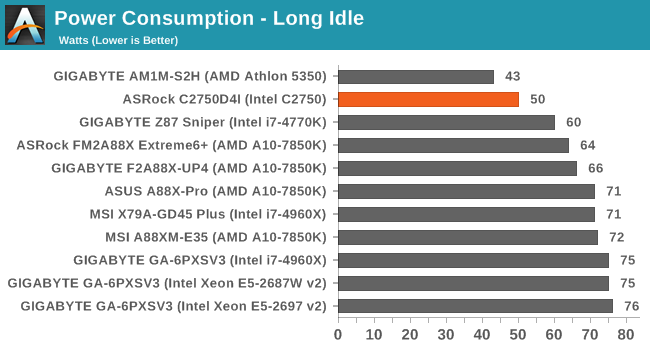
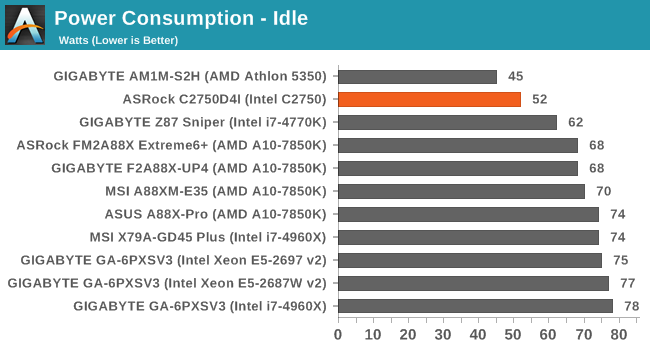
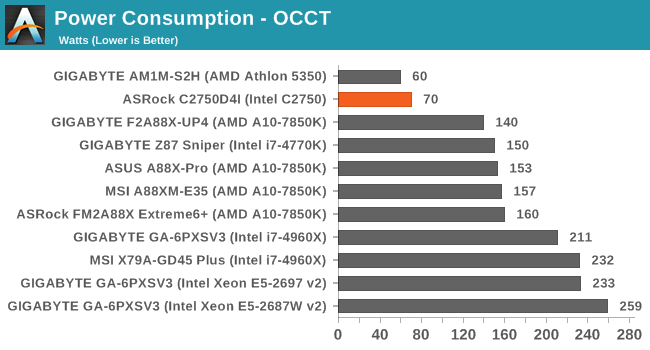
We added in the results from our 25W Kabini platform we are currently testing for a future review, just to show how much difference having the extra controllers and the remote management effects our idle and power loadings. It would therefore reveal that the extra featureset on the C2750D4I equates to 7-10W on our test bed.
Windows 7 POST Time
Different motherboards have different POST sequences before an operating system is initialized. A lot of this is dependent on the board itself, and POST boot time is determined by the controllers on board (and the sequence of how those extras are organized). As part of our testing, we are now going to look at the POST Boot Time - this is the time from pressing the ON button on the computer to when Windows 7 starts loading. (We discount Windows loading as it is highly variable given Windows specific features.) These results are subject to human error, so please allow +/- 1 second in these results.
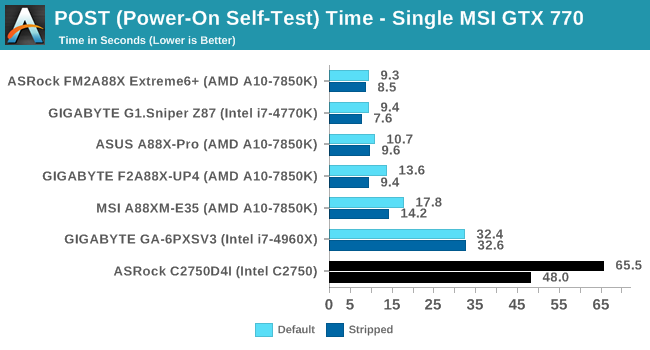
The issue with remote management systems is always the pre-initialisation time, which on the C2750D4I is unforgiving. However, it is often not a focus of a system such as this which might remain in constant operation for several years without a restart.


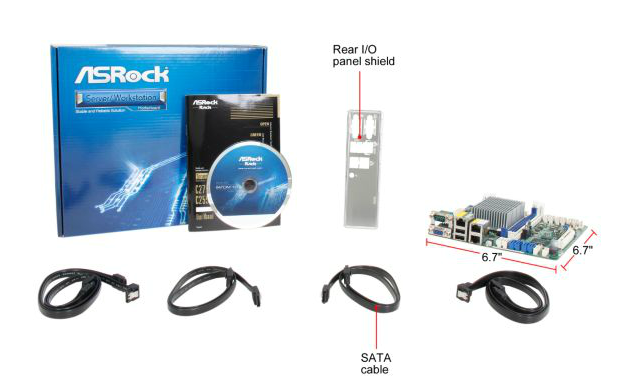








85 Comments
View All Comments
chekk - Tuesday, April 29, 2014 - link
Yes, for that price and target market, they should have gone with an LSI chip. You don't see Supermicro or Tyan boards in that price range using Marvell.cen - Tuesday, April 29, 2014 - link
I know it was said that the actual storage review is coming in the future but I think this article is a complete waste of time. You should simply let the storage review happen and not bother with this at all. More than half of the benchmarks are useless, the only ones of value might be encryption and compression.What we actually want to see is FreeNAS thrown in there with a 16TB ZFS zpool and some IO benchmarks. :)
Calista - Tuesday, April 29, 2014 - link
Could be perfect for anyone wishing to build a tiny box for virtualization, a task in which many a NIC, plenty of RAM and a multicore processor is most helpful.RandomUsername3245 - Tuesday, April 29, 2014 - link
I've wondered how one of these Avoton boards would compare to a Supermicro C2xx + Pentum G3430 (which supports ECC). This is the cheaper option if you don't need lots of ports, but once you add $100 for a sata card from Ebay, these options are similarly priced.Calista - Tuesday, April 29, 2014 - link
Could you please measure power consumption without the 770 as well? I have a HP Elite 8200 with a quad i5, SSD + 2.5" HDD, 32 GB RAM and an extra NIC as a makeshift box for ESXi and with 6-8 virtual machines running it draw less than 30 watt. It would be interesting to know how low this machine could go since any machine running 24/7 will add substantially to the power bill.Guspaz - Tuesday, April 29, 2014 - link
If I was using this in my home file server, I'd make a few changes to the board. The number of SATA ports is fine, because even though I've got 18 drives in mine, that PCIe slot lets you put in a SAS/SATA controller to get the total up as high as needed (16 port cards aren't hard to find, higher is available).However, I'd change a few things:
1) Replace the CPU. Home file servers can often be bottlenecked by individual CPU core performance, because not all filesystem operations on ZFS are multithreaded (although it's far better these days). For the ~25W TDP, I would much rather have a Haswell part, even if it meant fewer cores. For that TDP, you could get a ~3GHz dual-core part, or a ~2GHz quad-core part. Either of those would be better suited.
2) Add digital video output. HDMI, DVI, DisplayPort, any of them. I'm not suggesting using this thing for HTPC use, but many monitors these days are digital-only, and nothing is more annoying than trying to diagnose problems with a headless system when your motherboard is VGA-only and all you have is digital-only monitors.
3) Drop two of the RAM slots, and use them for another PCIe slot. Four slots is excessive for anything but enterprise use. Two slots cheaply gets you 16GB of RAM, or 32GB if you're desperate, either of which is more than enough for a home file server. A second PCIe slot, on the other hand, could enable a variety of other options, be they multiple SAS/SATA cards, a discrete video card if you really do want to use the thing as an HTPC, a video capture card (this board in that Silverstone case would probably make a decent HD-SDI recording box), etc.
4) More USB ports, prefereably 3.0. If extra space is needed for the ports, ditch one of the three GigE ports; two is plenty.
5) An mSATA slot for a boot drive could be useful, although it would probably increase board complexity by requiring some of the board components to move to the rear.
stoatwblr - Thursday, May 1, 2014 - link
"Two slots cheaply gets you 16GB of RAM, or 32GB if you're desperate"My ZFS media rig has 19 drives (21 including the ZIL and l2arc), plus boot media and at 36Tb it _needs_ 32Gb of ram to work efficiently. It kept bottlenecking at 16Gb. The next round of storage will push well past the 32Gb requirement.
+1 on the video output, +1 on usb3 - but I don't think it needs more ports. That's not a good fit for the target, which is a storage controller. Ditto on the mSATA.
If you need fewer cores there's a quad-core version which is cheaper.
I'd prefer that they placed a lsi sas controller onboard and dumped the sata ports for minisas (an expander cable is cheap, tidy and positively locks into place to ensure no problems.) The downside is that a decent sas controller would add at least $100 and a port multiplexer as much again.
If I was designing, I'd think about 10Gb copper, but that adds 15W to the power consumption and $150 to the price.
This thing is expensive for prosumers and limited for enterprise, but compromises are always like that. Supermicro's version has similar issues and the fact that they don't use minisas makes me think that perhaps Intel have placed restrictions on what can be used.
bernstein - Thursday, May 1, 2014 - link
well my zfs rig has 20 2.5" 2tb sata hdds (2x 16tb raidz2). no ZIL. no L2ARC.runs on a single 8GB ecc ddr2 dimm on a sandy bridge i3-2100T.
as a home fileserver this system rocks. it might be ram "bottlenecked" for high i/o tasks, but all i can see is that it performs at least as well as a single USB3 hdd... and it outperforms any consumer nas.
Daniel Egger - Tuesday, April 29, 2014 - link
For a NAS or SAN build this seriously lacks 10GbE and USB 3 ports. All in all this board seems like a pretty strange amalgamation of random features, as there're better choices for about any possible use case around.Gunbuster - Tuesday, April 29, 2014 - link
14000 RPM Delta fans? No Thanks!I would have called it the AssRack. Sorry I couldn't resist!